
Alexander Heinle
Alex is a marketer at Zavvy. On this blog, he mainly shares insights gained from discussions with selected experts and from helping our customers set up and improve their onboarding or learning programs.


Many HR leaders fear feedback–it's the monster of workplace cultures. Having to sit face-to-face with an employee could be a nightmare.
On the contrary, creating a feedback culture is one of the best gifts you can give your team. 33% of employees say they prefer to receive more feedback from their supervisors. It helps them recognize their strengths, address skill gaps, and grow within the organization.
As employees transcend into the development and engagement phase, they should receive recognition and constructive performance reviews for improved productivity. But unfortunately, not all managers know how to give feedback effectively.
Together with our curators, we have created a library of actionable digital marketing resources. Personalized to your team's needs.
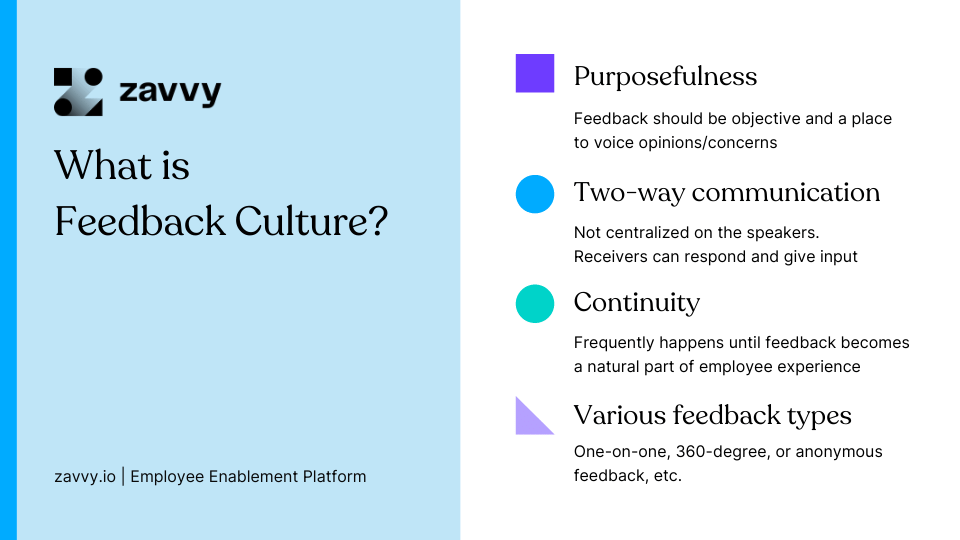
A feedback culture is the habit of sharing, responding, and acting on feedback between employees and management. Feedback culture should apply to anyone, regardless of the position–whether you're the manager or low-level staff.
A healthy feedback culture has the following components:
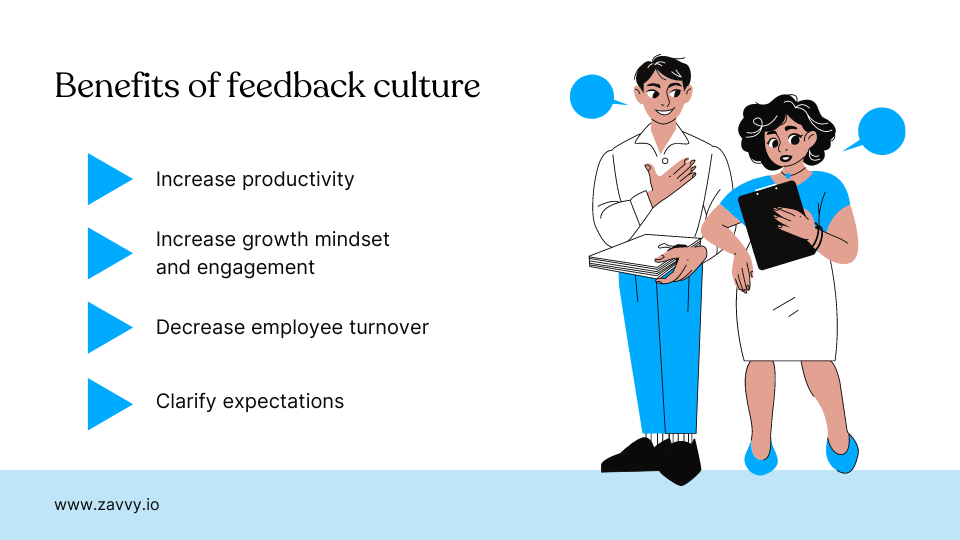
The main aim of giving feedback is to increase the high-quality work and, if possible, its quantity. By letting your team know which part of their job could be improved and how to do it, you are creating your way to achieving the goal.
Moreover, once the team found the best methods to do their tasks, they are expected to become proactive. As a result, managers are assured that the business can run smoothly even without much interference from the team leaders.
At this point, communication will become seamless and almost "wordless" because everyone is on the same page. The team understands what is acceptable and what doesn't base on the organization's workflow.
The bigger your business, the more people you have–and the easier it is to ignore giving feedback. Consequently, employees could feel unseen, unheard, and unappreciated for their contributions.
Employees who frequently receive feedback are 4.6 times more willing to give their best in accomplishing goals and fulfilling tasks. Additionally, organizations with engaged workers are 22% more profitable and less likely to experience losses from offboarding and rehiring.
Creating a feedback culture can prevent your organization from financial loss. It costs 20% of a month's salary to replace one employee. Helping your workers learn from their mistakes can improve their performance and develop their skills.
Adopting the feedback culture from the first 30-60-90 working days ensures everyone knows their role. New hires will feel more connected to your organization when they see the company's expectations, and they can adjust their work to meet the goals.
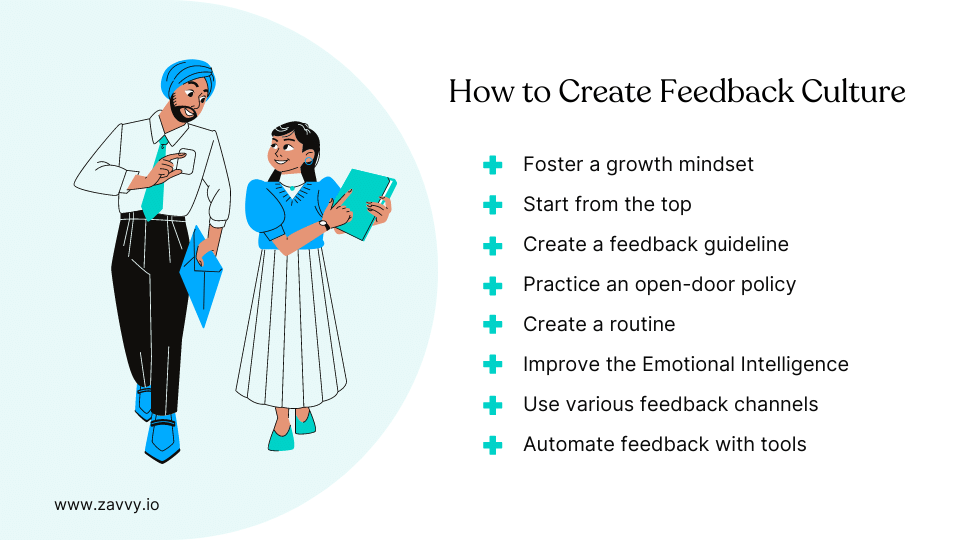
Giving feedback is not easy. Practicing the culture of learning and assessing goes beyond telling your employees what area they're good at and what domain they need to improve.
That said, providing feedback is an integral tool for organizational success and should be treated with utmost priority. Here are eight feedback culture best practices you can leverage for organizational success:
A leader with a growth mindset develops a passion for learning and is open to change. They understand that although the employees are skilled, there is always room for improvement.
When you tell someone that they can do better at their job, it can easily be misinterpreted as an attack. Consequently, feedback often gets buried under the rug to avoid these sensitive conversations, and everyone carries on with what they're doing.
Employees may become defensive and continue to work like normal. They don't see anything wrong with their performance or feel the need to improve. Avoid being the bad guy by offering training programs and courses for everyone, leaders included.
To avoid some misunderstandings, follow these tips:
Only 14.5% of managers give effective feedback, while the rest falls into two groups (Leanne Renninger, Founder of LifeLabs Learning). One group consists of indirect and soft managers, and the other group describes the opposite. Maintaining the balance can be tricky, especially if you've never had experience or received training in doing it.
On that note, you must practice what you preach. Look in the mirror. If you're doing things contrary to the growth mindset you've built as a leader, halt them and begin setting boundaries.
From the top of the hierarchy to the bottom, everyone should understand the value of the feedback culture. Become a role model in giving feedback with the following steps:
A guideline will help define the outline, structure, and best strategies to let the recipients know their performance results.
The guideline should answer these four questions:
Support the guideline with materials or videos on good and bad feedback interactions. Then, you can take it to the next level by performing a live demonstration with an employee. They can practice the act of peer-reviewing and show that feedback shouldn't always come from the top to the bottom of the hierarchy.
Encouraging employees to come to you for assistance builds trust and improves communication. You can discover pain points you didn't even know existed by addressing their concerns, questions, or suggestions outside the regular chain of command.
While an open-door policy sounds nice, it's crucial to set the tone. It is intended so that employees don't misuse the opportunity given to them–for example, turning performance evaluation into a gossip session.
For an open door policy to work, practice the following steps:
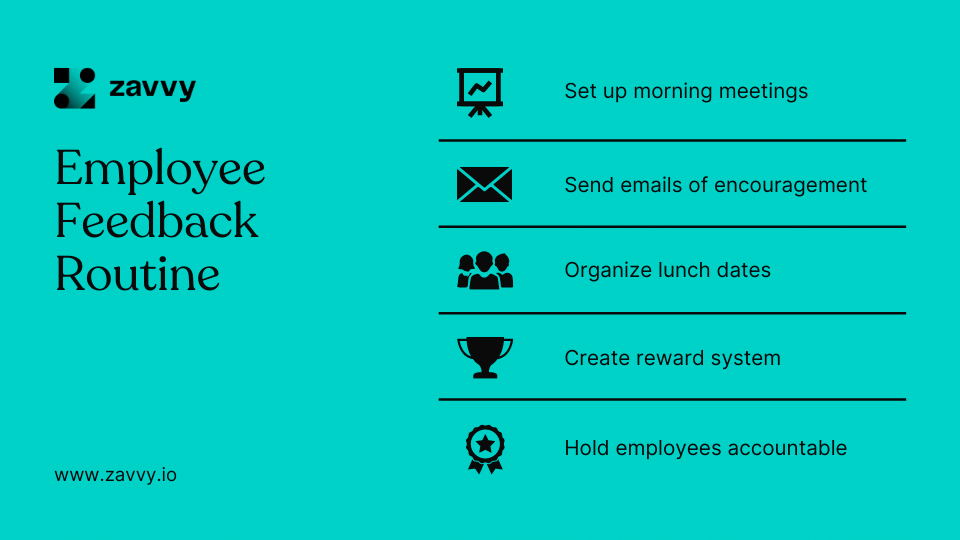
Make feedback a systematic process. Don't postpone it to the end of the year. Employees will most likely forget everything they've experienced and resume with their work style.
For individual projects, 1-on-1 interaction is the best strategy. Spend some time to discuss the hurdles and find solutions together.
For feedback on group projects, set up a cohort meeting. Create a group-based meeting agenda where everyone can contribute. Encourage the team to share the challenges and winnings from working on the project. This way, you avoid the meetings to go off-track and increase team collaboration.
Though feedback doesn't have to happen every day, you can incorporate it into your daily communication. For example, you can ask short and quick questions like, "Sarah, how's the social media campaign coming along?" or "Are you having any challenges with the project?".
Other ways you can give subtle feedback include the following:
Stop being a robotic boss and be aware of the emotions of the people around you. Put yourself in their shoes and display genuine empathy towards their performance. This point is vital to avoid any unwanted side-effects from exchanging feedback.
Therefore, balancing empathy with constructive criticisms is essential for giving effective feedback. You can detect how to provide feedback and what approach fits that person or situation. Developing your emotional intelligence begins with the following step:
Some employees may respond to feedback better in one-on-one meetings, while others prefer to do it anonymously. That is why we suggest having a flexible feedback system.
All employees are not the same, so you should tailor feedback to suit everyone's comfort level. It also saves time in a fast-paced and dynamic environment where employee roles are constantly changing.
We collected some feedback channels you should leverage in your organization to ensure fairness in communicating feedback:
Replace paper surveys and complement face-to-face interactions with feedback software. Compose dynamic and unique surveys to draw effective responses, and then use feedback software to analyze the data automatically. This will reduce human error rates from manual processes and help you make informed decisions.
Software like Thematic and Qualtrics can unify data, regardless of the feedback channel. In addition, some tools are open-source and can be tweaked to accommodate your organization's size and feedback system.
Consider the factors below before choosing a feedback software:
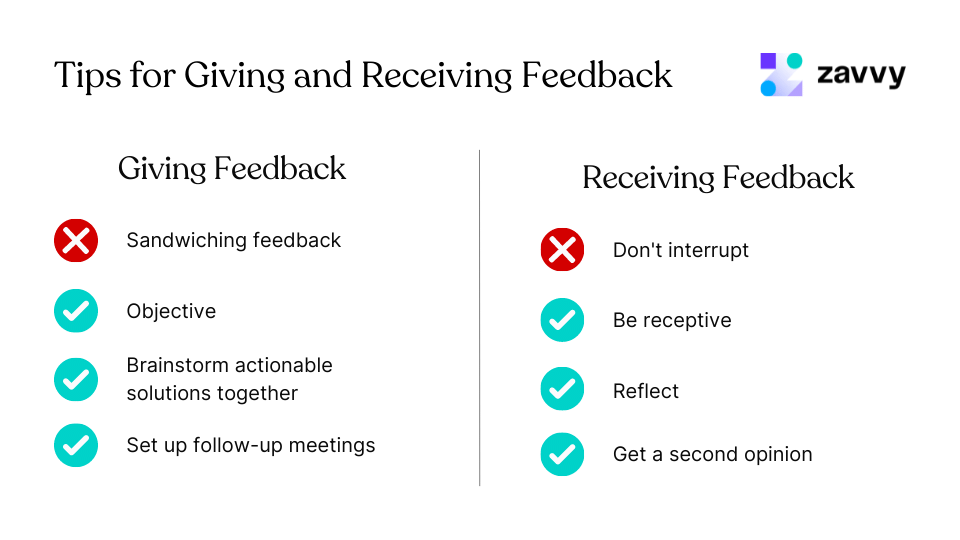
Avoid sandwiching feedback - Kickstart the conversation with a positive statement. Compliment the receiver on something they've accomplished recently. Then give constructive criticism. Go into details on where they excelled and where they need to improve.
Stay objective - Don't bring personal beef into the conversation. Feedback is not about your differences but facts. Most importantly, go straight to the point so you don't confuse them.
Brainstorm actionable solutions together - End the conversation with realistic solutions on how your listener can improve. Don't tell them what to do. Instead, suggest options. When possible, mention case studies of how those suggestions have worked before.
Follow-up - Make plans to have another meeting. Decide on a convenient date for both parties. Follow-up meetings should focus on comparing your progress since the last session. Set SMART goals you can both accomplish before every meeting.
Don't interrupt - Listen to the speaker until they're done talking. Even if the feedback isn't on-target, be patient. Take notes while you listen and discuss the missed information the speaker may have.
Be receptive - Your speaker will most likely offer suggestions during feedback. Don't be defensive. Instead, welcome their ideas and ask questions to help you understand their point of view better. Maintain welcoming body language and make eye contact. Don't lean away from the speaker or roll your eyes when they say something you disagree with.
Reflect - Use a maximum of five minutes to revise the discussion and ensure that both parties are on the same page. If there's any detail you missed, use this time to touch them. Then ask yourself internally: What have I learned from this? Are the suggestions feasible or not?
Get a second opinion - If necessary, ask another person to give feedback on the same matter. After all, the input is one opinion in a sea of many. You can then start making plans to adjust your behavior based on the multiple evaluations.
Trading Kudos cards, giving frequent performance reviews and fostering a collaborative environment make Henkel, Zoom, and Google stand out from the competition. You can use their work culture examples to inspire your feedback strategy.

Henkel's new feedback culture has shifted from conventional methods. The company created a system that horizontally distributes feedback rather than the top-to-down approach. With a large team of 53,000 employees, this strategy guaranteed visibility for everyone.
Managers are no longer the only source of feedback. Employees can receive Kudos cards and reviews from peers. Henkel strengthens this system by incentivizing high-performing employees with rewards.

Zoom was listed among the Glassdoor Employees Choice Awards winners in 2021. Employee reviews on Comparably.com reveal that Zoom employees receive constructive feedback every week. At the same time, an all-hands-on-deck meeting is set up every quarter.
New team members are assigned to coaches or mentors who initiate them into the culture and teach them the company's ropes. In addition, a Happy Crew is formed to create experiences to help employees stay productive and boost morale to complement this culture.

Google operates a flat organizational structure, which allows for a collaborative environment. Low-level employees can trade opinions and express concerns directly with the CEO, and peer review is treated with great importance.
The company also hosts pep talk sessions where employees are encouraged with incentives to share their innovative ideas. They are also provided with the necessary resources to turn those ideas into realities.
Giving feedback can be as uncomfortable as having "the talk" with teenagers. But by not talking about the strengths and weaknesses, you miss the opportunity to make incremental improvements for your team. It presents immense benefits to organizations, such as employee retention, morale, and productivity-booster.
Turn the feedback results into a plan to develop your staff. We've devised a development program to help you engage employees with tasks and reflection activities for a healthy growth culture. Talk with us to see the feature in action.

A feedback culture is the habit of sharing, responding, and acting on feedback between employees and management. Feedback culture should apply to anyone, regardless of the position–whether you're the manager or low-level staff.
A healthy feedback culture has the following components:

The main aim of giving feedback is to increase the high-quality work and, if possible, its quantity. By letting your team know which part of their job could be improved and how to do it, you are creating your way to achieving the goal.
Moreover, once the team found the best methods to do their tasks, they are expected to become proactive. As a result, managers are assured that the business can run smoothly even without much interference from the team leaders.
At this point, communication will become seamless and almost "wordless" because everyone is on the same page. The team understands what is acceptable and what doesn't base on the organization's workflow.
The bigger your business, the more people you have–and the easier it is to ignore giving feedback. Consequently, employees could feel unseen, unheard, and unappreciated for their contributions.
Employees who frequently receive feedback are 4.6 times more willing to give their best in accomplishing goals and fulfilling tasks. Additionally, organizations with engaged workers are 22% more profitable and less likely to experience losses from offboarding and rehiring.
Creating a feedback culture can prevent your organization from financial loss. It costs 20% of a month's salary to replace one employee. Helping your workers learn from their mistakes can improve their performance and develop their skills.
Adopting the feedback culture from the first 30-60-90 working days ensures everyone knows their role. New hires will feel more connected to your organization when they see the company's expectations, and they can adjust their work to meet the goals.

Giving feedback is not easy. Practicing the culture of learning and assessing goes beyond telling your employees what area they're good at and what domain they need to improve.
That said, providing feedback is an integral tool for organizational success and should be treated with utmost priority. Here are eight feedback culture best practices you can leverage for organizational success:
A leader with a growth mindset develops a passion for learning and is open to change. They understand that although the employees are skilled, there is always room for improvement.
When you tell someone that they can do better at their job, it can easily be misinterpreted as an attack. Consequently, feedback often gets buried under the rug to avoid these sensitive conversations, and everyone carries on with what they're doing.
Employees may become defensive and continue to work like normal. They don't see anything wrong with their performance or feel the need to improve. Avoid being the bad guy by offering training programs and courses for everyone, leaders included.
To avoid some misunderstandings, follow these tips:
Only 14.5% of managers give effective feedback, while the rest falls into two groups (Leanne Renninger, Founder of LifeLabs Learning). One group consists of indirect and soft managers, and the other group describes the opposite. Maintaining the balance can be tricky, especially if you've never had experience or received training in doing it.
On that note, you must practice what you preach. Look in the mirror. If you're doing things contrary to the growth mindset you've built as a leader, halt them and begin setting boundaries.
From the top of the hierarchy to the bottom, everyone should understand the value of the feedback culture. Become a role model in giving feedback with the following steps:
A guideline will help define the outline, structure, and best strategies to let the recipients know their performance results.
The guideline should answer these four questions:
Support the guideline with materials or videos on good and bad feedback interactions. Then, you can take it to the next level by performing a live demonstration with an employee. They can practice the act of peer-reviewing and show that feedback shouldn't always come from the top to the bottom of the hierarchy.
Encouraging employees to come to you for assistance builds trust and improves communication. You can discover pain points you didn't even know existed by addressing their concerns, questions, or suggestions outside the regular chain of command.
While an open-door policy sounds nice, it's crucial to set the tone. It is intended so that employees don't misuse the opportunity given to them–for example, turning performance evaluation into a gossip session.
For an open door policy to work, practice the following steps:

Make feedback a systematic process. Don't postpone it to the end of the year. Employees will most likely forget everything they've experienced and resume with their work style.
For individual projects, 1-on-1 interaction is the best strategy. Spend some time to discuss the hurdles and find solutions together.
For feedback on group projects, set up a cohort meeting. Create a group-based meeting agenda where everyone can contribute. Encourage the team to share the challenges and winnings from working on the project. This way, you avoid the meetings to go off-track and increase team collaboration.
Though feedback doesn't have to happen every day, you can incorporate it into your daily communication. For example, you can ask short and quick questions like, "Sarah, how's the social media campaign coming along?" or "Are you having any challenges with the project?".
Other ways you can give subtle feedback include the following:
Stop being a robotic boss and be aware of the emotions of the people around you. Put yourself in their shoes and display genuine empathy towards their performance. This point is vital to avoid any unwanted side-effects from exchanging feedback.
Therefore, balancing empathy with constructive criticisms is essential for giving effective feedback. You can detect how to provide feedback and what approach fits that person or situation. Developing your emotional intelligence begins with the following step:
Some employees may respond to feedback better in one-on-one meetings, while others prefer to do it anonymously. That is why we suggest having a flexible feedback system.
All employees are not the same, so you should tailor feedback to suit everyone's comfort level. It also saves time in a fast-paced and dynamic environment where employee roles are constantly changing.
We collected some feedback channels you should leverage in your organization to ensure fairness in communicating feedback:
Replace paper surveys and complement face-to-face interactions with feedback software. Compose dynamic and unique surveys to draw effective responses, and then use feedback software to analyze the data automatically. This will reduce human error rates from manual processes and help you make informed decisions.
Software like Thematic and Qualtrics can unify data, regardless of the feedback channel. In addition, some tools are open-source and can be tweaked to accommodate your organization's size and feedback system.
Consider the factors below before choosing a feedback software:

Avoid sandwiching feedback - Kickstart the conversation with a positive statement. Compliment the receiver on something they've accomplished recently. Then give constructive criticism. Go into details on where they excelled and where they need to improve.
Stay objective - Don't bring personal beef into the conversation. Feedback is not about your differences but facts. Most importantly, go straight to the point so you don't confuse them.
Brainstorm actionable solutions together - End the conversation with realistic solutions on how your listener can improve. Don't tell them what to do. Instead, suggest options. When possible, mention case studies of how those suggestions have worked before.
Follow-up - Make plans to have another meeting. Decide on a convenient date for both parties. Follow-up meetings should focus on comparing your progress since the last session. Set SMART goals you can both accomplish before every meeting.
Don't interrupt - Listen to the speaker until they're done talking. Even if the feedback isn't on-target, be patient. Take notes while you listen and discuss the missed information the speaker may have.
Be receptive - Your speaker will most likely offer suggestions during feedback. Don't be defensive. Instead, welcome their ideas and ask questions to help you understand their point of view better. Maintain welcoming body language and make eye contact. Don't lean away from the speaker or roll your eyes when they say something you disagree with.
Reflect - Use a maximum of five minutes to revise the discussion and ensure that both parties are on the same page. If there's any detail you missed, use this time to touch them. Then ask yourself internally: What have I learned from this? Are the suggestions feasible or not?
Get a second opinion - If necessary, ask another person to give feedback on the same matter. After all, the input is one opinion in a sea of many. You can then start making plans to adjust your behavior based on the multiple evaluations.
Trading Kudos cards, giving frequent performance reviews and fostering a collaborative environment make Henkel, Zoom, and Google stand out from the competition. You can use their work culture examples to inspire your feedback strategy.

Henkel's new feedback culture has shifted from conventional methods. The company created a system that horizontally distributes feedback rather than the top-to-down approach. With a large team of 53,000 employees, this strategy guaranteed visibility for everyone.
Managers are no longer the only source of feedback. Employees can receive Kudos cards and reviews from peers. Henkel strengthens this system by incentivizing high-performing employees with rewards.

Zoom was listed among the Glassdoor Employees Choice Awards winners in 2021. Employee reviews on Comparably.com reveal that Zoom employees receive constructive feedback every week. At the same time, an all-hands-on-deck meeting is set up every quarter.
New team members are assigned to coaches or mentors who initiate them into the culture and teach them the company's ropes. In addition, a Happy Crew is formed to create experiences to help employees stay productive and boost morale to complement this culture.

Google operates a flat organizational structure, which allows for a collaborative environment. Low-level employees can trade opinions and express concerns directly with the CEO, and peer review is treated with great importance.
The company also hosts pep talk sessions where employees are encouraged with incentives to share their innovative ideas. They are also provided with the necessary resources to turn those ideas into realities.
Giving feedback can be as uncomfortable as having "the talk" with teenagers. But by not talking about the strengths and weaknesses, you miss the opportunity to make incremental improvements for your team. It presents immense benefits to organizations, such as employee retention, morale, and productivity-booster.
Turn the feedback results into a plan to develop your staff. We've devised a development program to help you engage employees with tasks and reflection activities for a healthy growth culture. Talk with us to see the feature in action.
Upskill your team every week with the best contents and personalized recommendations.

Many HR leaders fear feedback–it's the monster of workplace cultures. Having to sit face-to-face with an employee could be a nightmare.
On the contrary, creating a feedback culture is one of the best gifts you can give your team. 33% of employees say they prefer to receive more feedback from their supervisors. It helps them recognize their strengths, address skill gaps, and grow within the organization.
As employees transcend into the development and engagement phase, they should receive recognition and constructive performance reviews for improved productivity. But unfortunately, not all managers know how to give feedback effectively.
Get a demo!
We'll be happy to show you around and answer all your questions.
Trusted by innovative companies



We'll be happy to show you around, answer your questions, or arrange a free trial.
Erhalten Sie eine kostenlose Demo unserer Onboarding-Software.
Vertraut von



Your Training & Development Strategy - Solved in 1 Tool.
Trusted by innovative companies



We'll be happy to show you around, answer your questions, or arrange a free trial.
Learn how Zavvy helps you drive performance, development, and engagement.
Trusted by innovative companies



We'll be happy to show you around, answer your questions, or arrange a free trial.
We'll be happy to show you around and answer all your questions.
Trusted by innovative companies



We'll be happy to show you around, answer your questions, or arrange a free trial.
Gerne zeigen wir Ihnen ganz unverbindlich unsere Plattform im Detail.
Vertraut von modernen Unternehmen



Get a demo!
We'll be happy to show you around and answer all your questions.
Trusted by innovative companies



We'll be happy to show you around, answer your questions, or arrange a free trial.
Erhalten Sie eine kostenlose Demo unserer Software für Mitarbeiterenwicklung und Training.
Moderne Unternehmen
setzen auf Zavvy


